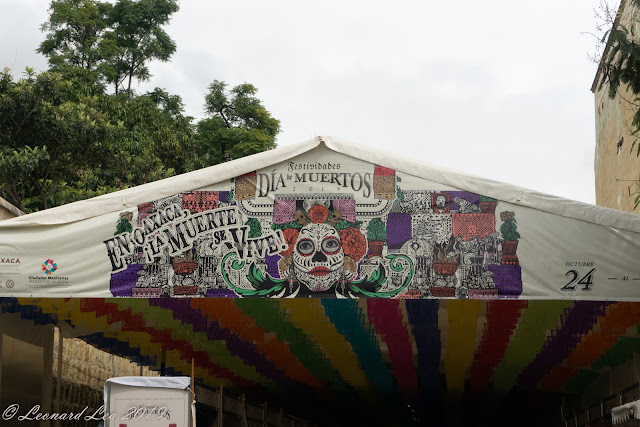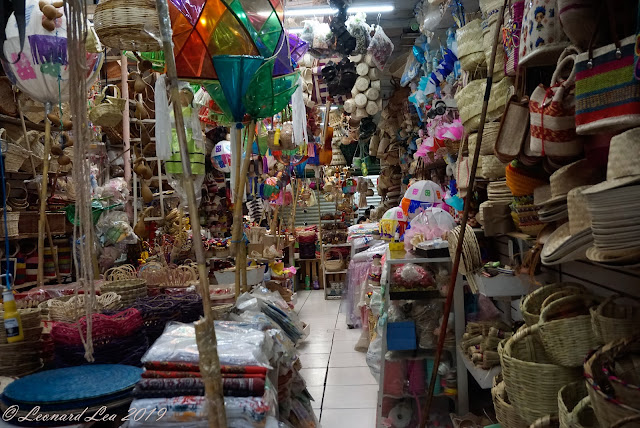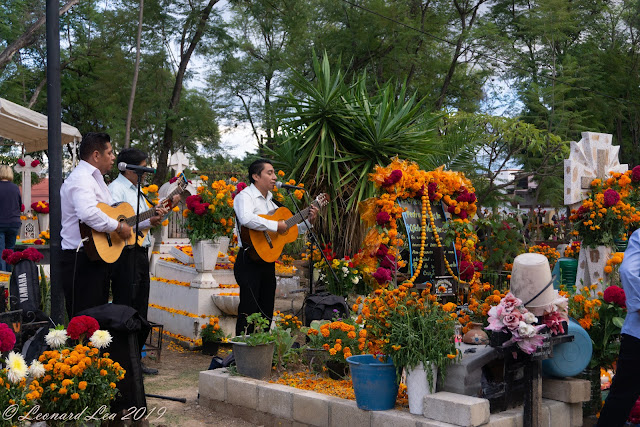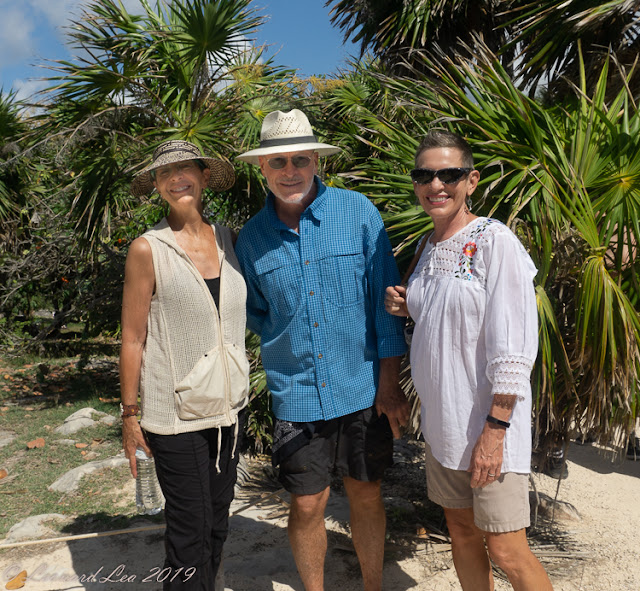Our most recent adventure was to a week-long workshop over Day of the Dead in Oaxaca. This city is quite famous for it's activities over this festival, so attracts many visitors.
Our workshop, led by Humberto Batista, a local mixed media artist, and Mari Seder, a photographer from Massachusetts, was intended to teach us some of the background and meaning behind this celebration, visit cemeteries, and produce our own alter, if we chose.
We flew from Guadalajara to Oaxaca via Mexico City, which was an interesting start to our day.
The flight from Guadalajara left slightly late, but landed about on time. The challenge then became to locate our gate for the next leg of our journey. We endured three gate changes with the final gate loading three different flights all at about the same time, and no signs to indicate which flight was boarding, or when. All announcements are in Spanish! We managed to talk to other passengers who were on our flight who spoke English to try and figure out what was happening. In the end it all worked out, after quite a long delay, with the majority of passengers patient and smiling. Viva Mexico!
After another adventure in getting transport to our hotel, we were able to relax and settle into our rather sparse room .
This was the lobby area in the beginning stages of Day of the Dead.
The next morning we set out to find breakfast and ended up on this roof-top terrace with views over Oaxaca and some of the surrounding hills.
Colourful buildings along the street to the restaurant.
All of the streets were made of flagstone and were delightfully smooth, a nice change from our village cobbled streets. Everything was clean and regularly swept by hand with these brooms!
We were well-situated in the Centro Historico. One of the attractions is the church, Santo Domingo, built between 1570 and 1608, as part of the Dominican monastery. It is extremely ornate with all of the carvings inside the church covered in gold leaf.
This church has a large plaza at it's front and is a popular location for weddings and christenings.
Hard to photograph, but, hopefully, this gives some idea of the ornate nature.
Work was underway in a side chapel being re-gilded, quite a sight.
This church, because of it's spectacular interior, is often mistaken for Oaxaca Cathedral.
This is the Cathedral, next to the large plaza or "zocalo".
Again a pretty impressive interior. We were very surprised to see huge quantities of flower arrangements, a few of which are visible in the photo. All were fresh flowers, so the scent was very nice. We learned later that the church had probably been decorated like this for a wedding.
We had several days to wander the city before our workshop began, and much to my surprise, we discovered that Oaxaca has a thriving print making activity. This is one of several studios near our hotel.
We also found a library devoted entirely to print making and associated arts.
It almost goes without saying, this is Mexico after all, there were parades most days, colorful and loud.
And another!
Many street artists, but this one was especially endearing, so we did add to his bowel.
Dia de Muertos is an important celebration in this city. Many tourists flock to the town during the week prior, and the majority of visitors appear to be from Mexico. For this week a large fair is organized with artisans from the surrounding towns selling and exhibiting their crafts.
Everything was in a large exhibit tent and very professionally done.
We happened upon a wedding at Santo Domingo, where large figures depicted the bride and groom. The paper balloon carried the first names of the couple to greet them as they leave the church.
The couple then have their first dance surrounded by ethnic dancers. Unfortunately, we did not understand the significance of this.
I was intrigued by this little lady touting her wares among the wedding guests. I think she did a good trade.
Not sure of any particular role these ladies had in the wedding, but they were surely "strutting their stuff."
We always like to visit the markets where the locals do their shopping. This market is the Central de Abastos and you can get virtually anything you want. Finding it takes some searching in the many narrow and confusing passageways.
Dried fish in plentiful supply
And chickens! We have yet to find the pale chickens found north of the border, I guess the hens eat a lot of maize here, or marigolds!
Since it was the week before Day of the Dead , lots of sugar skulls!
As we had planned to visit Monte Alban later in our stay, we decided to pay a visit to the cultural museum, which turned out to be a special treat.
Monte Alban is one of the earliest cities in Mesoamerica being founded in about 500BC. It was the center of the Zapotec culture for over 1,000 years.
The artifacts in this museum are focused on the objects found at the site known as "Tomb 7", originally excavated in 1932.
Monte Alban covers a large area on the hills overlooking the city of Oaxaca. In the photo above, the line is depicting the location of Tomb 7 where the famous skull was found.
There was an amazing display of gold filigree work
Many beads were found on the site and these were restrung to indicate how the complete necklace would have looked.
Some more amazing gold ornaments
We took an organized tour of the Monte Alban site, which was not quite what we had expected. We signed up for an English tour guide, and we started out as a small group. After riding the tour bus to the monument we were joined by a second group, mostly Spanish speakers. This resulted in our guide having to present his talk in both Spanish and English, making the tour take twice as long as it should have.
An explanation of the ball court
.
As you can see, the site is very large with many pyramids and structures that were not described in any detail. Should we go again, I think it would be beneficial to hire a private guide!
As I mentioned at the start of this blog, we had come to Oaxaca to attend an art workshop centered on the Day of the Dead. The workshop was held in the studio of one of the leaders, Humberto, and our opening dinner was held in his studio. The intent of the workshop was to offer the opportunity to construct a small "Ofrenda" or "Altar de Muertos", which means a collection of objects assembled into a display, generally to commemorate someone who has died.
Each workshop participant had their own idea of what they wanted to commemorate. Diane and I decided to commemorate our parents.
Each participant was provided a small "box" and were given a small area on the long worktable to begin the process. We had been encouraged to bring items we might want to use, and we were also taken shopping to find additional items. The locations included a local "antique" shop run by a friend of Humberto, and a manualidades (like a Michael's craft store). Humberto and Mari provided a lot of encouragement to be creative.
Humberto and Mari were available to answer questions and provide guidance. Some participants were disappointed in the small work area, but Humberto showed us the very small space that he uses to create his art, and was encouraging us to do the same.
Humberto's studio itself was a great source of inspiration, just by looking closely at the many works of art, often created from found objects.
Diane hard at work on her Ofrenda.
Len having a lot of fun doing something totally new.
As part of the workshop we went to visit several cemeteries, some after dark. The photography was a challenge, but the experience was moving.
A great deal of love, care and attention is evident on all of the graves as they are highly decorated with fresh flowers, marigolds being the main choice, as the bright color leads the departed "home".
It is encouraging to see the participation of the whole family at the gravesides, with children being taught that death is not to be feared.
It is a time to welcome departed family members to return and celebrate with the living.
It is a time to sit with departed loved ones who have returned to visit on this important occasion
These few photos cannot do justice to the magnitude of these days in Mexico. It was very crowded, loud and at some level a boisterous "happening".
If you have not seen the film "Coco", I wold encourage you to do so in order to get a good explanation of Día de Muertos.
This is Diane's Ofrenda honoring her parent's memory.
This is Len's Ofrenda honoring his parent's memory. I don't know why the "Oriental bus driver's fringe" got in there, it just did!
That's it for now. There are several more adventures from this last year in Mexico which I will try to recall and add to another blog.
See you in 2020.


































































